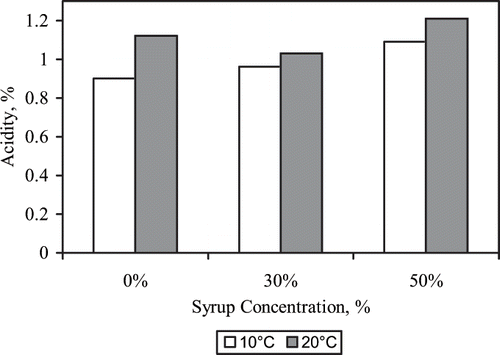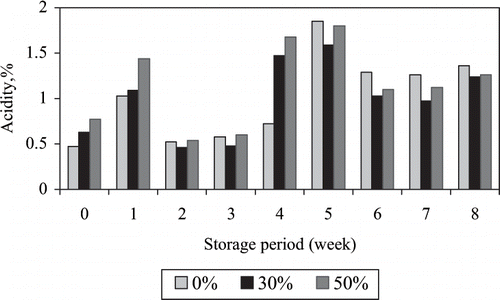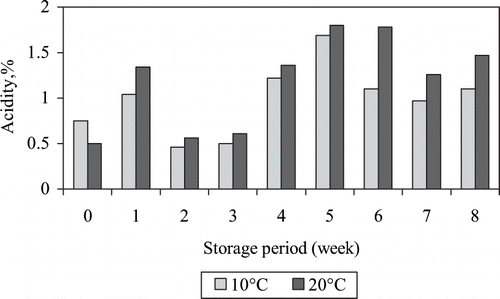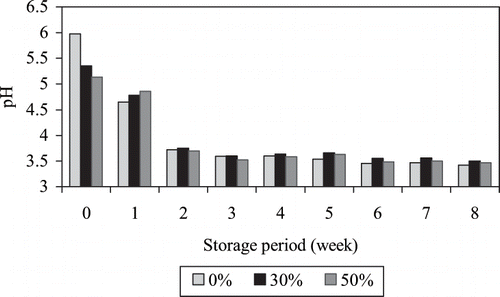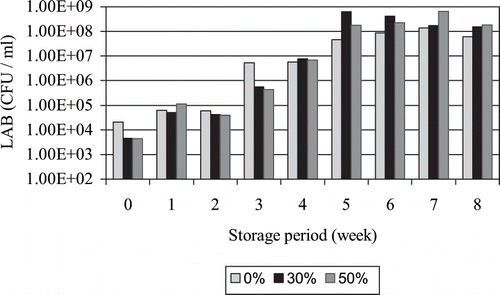Abstract
In the production of medlar pickle was used saccharose concertrations of 0.0%, 30% and 50% as basis of water. Preparing pickles were stored at 10°C and 20°C. During the storage period, the level of acidity and lactic acid bacteria (LAB) counts of pickle samples increased while the levels of pH decreased. This situation was slow in pickles stored at 10°C. The increase of saccharose concentration caused an increase in acidity and LAB count of pickles. The values of the final acidity (%) and pH of the pickles were 1.29 and 3.46, respectively. Lactic acid bacteria counts also increased during the storage period and reached to 108 CFU/ml at the end of 8 weeks. The increase of temperature shortened fermentation duration but mold growth on surface of pickles was abserved.
INTRODUCTION
Medlar pickle is a domestic pickle variety which is produced and willingly consumed in Turkey. The pickle production from various fruits and vegetables were known for a long time. Some beverages are produced by fermentation besides various solid foods.[Citation1,Citation2] Presently, many fruits and vegetables have been converted to products, such as pickle, that have a different taste and odor. Fruits and vegetables are plentifully and cheaply purchased in summer and generally used in pickle production. These pickles are then consumed in winter. The medlar tree (Mespilus germanica L.) is a member of the Rosaceae family and is native to south Eastern Europe, Anatolia, Climea, and Caucasia. Its fruits are crabapple-size, when ripe, and they become brown, soft and sweet, when pickled. The fruits are also used as folk medicines, primarily in the treatment of constipation, in the removal of kidney and bladder stones, or as a diuretic.[Citation3] Negligible information is available on microbial and chemical composition of medlar pickle. In this article, the chemical and microbiological characteristics of medlar pickle using the different sugar concentrations were determined during the storage.
MATERIALS AND METHODS
Material
Medlar fruits (Mespilus germanica) growing on Erzurum province of Turkey were used in medlar pickle production. Medlar fruits, hard and undamaged, were cleaned from damaged fruits and washed in water. The mixture of two parts water, one part medlar fruit, and 0.0 (control), 0.5, and 0.3 parts saccharose (w/v/w) were used in pickle production. The saccharose and water mixing (syrup) was first boiled and then cooled; then medlar fruits were poured into these syrups. This final mixing was stored for 8 weeks and analyzed every week for microbiological and chemical properties during the storage period. The research was conducted in three replications, and statistical significance of means was evaluated by analysis of variance using the SPSS for windows release 10.0.1 pocket program.
Methods
Microbiological analyses
The number of lactic acid bacteria was determined as described by Erginkaya and Hammes.[Citation1] For this purpose, the appropriate dilutions samples were prepared and inoculated on MRS-Agar and incubated at 32°C for 3 days.
Chemical analysis
The levels of pH were determined in the juice of medlar pickle using pH-meter (Orion-ATI 420A). Acidity was measured by electrometer titration procedures. For this purpose, 100 ml of pickle juice was put into a beherglass and mixed by magnetic stirrer. The final point of titration was determined as pH 8.1 when titrated with 0.1 N NaOH. The acidity (%) was calculated as to malic acid.[Citation1,Citation4]
RESULTS AND DISCUSSION
The change of pH, acidity and LAB counts during the storage were presented in . Acidity has increased at the end of 1st week, but decreased rapidly at the end of the 2nd week; it then increased at the end of 4th week again and reached the maximum level at the end of week 5. The increase of acidity from LAB at the beginning and then the decrease of acidity from yeasts forming the dominant flora may cause to this situation.[Citation5] At the end of the 1st and 2nd weeks, the pH of the pickles decreased sharply. This decrease was slow in the following weeks. At the beginning, lactic acid bacteria quickly reduced pH and this decrease slowed down the activity of LAB. Nevertheless, the numbers of LAB increased during the storage period.[Citation6]
Table 1 The effects on LAB counts of the storage period, acidity and pH.
The effect on pH, acidity and LAB counts of the different syrup concentrations were presented in . It was detected that the levels of acidity of pickles were higher in syrup of 50% than 30%. The levels of pH and LAB counts of syrups with 50% saccharose were also found in high levels than others, since saccharose in the pickles could be used by LAB as substrate. The effect of the different syrup concentrations and temperature on acidity was shown in . The acidity was in high level at 20°C than 10°C. This situation may be explained that the LAB grown more at 20°C. As shown in , the storage period and the sugar concentration importantly affected the acidity. The acidity increased in the 1st, 4th, and 5th weeks, decreased in further weeks, and increased in the last week again.[Citation7] The increase of acidity by LAB in the first week, and the decrease of acidity by yeasts in the further weeks may explain this situation. The effects of the storage period and temperature on the acidity of the pickles were presented . At the end of the first week, the acidity was in higher level at 20°C than 10°C. The acidity decreased in 2nd and 3rd weeks since the acids may be used by the yeasts. The acidity increased again in 4th and 5th weeks due to the dominant LAB flora. After 5 weeks, the acidity was decreased again.[Citation8] As shown in , at the beginning, pH levels were not same because of the different syrup concentrations. In the following weeks, the pH of all the pickles similarly decreased until 2nd weeks. The decrease was stable after this week, since the acidity was increased by the LAB. As shown in , the numbers of LAB generally increased during storage. After 5 weeks, it was shown that the numbers of LAB had not changed. This situation may arise from the decrease in sugar concentrations and pH of the pickles. On the other hand, the formation of alcohol and similar metabolites in medlar pickles may negativity have effected microbiological action in the pickles.[Citation9–11] In addition, some acid is lost during fermentation thus reducing the total acidity and raising the pH. Lactic acid bacteria principally are responsible for fermentation. These bacteria are naturally resident in the pickle or commercial strains may be inoculated. The growth of LAB in wine is influenced by factors such as pH, alcohol concentration, temperature and nutrient availability.[Citation12]
Table 2 The effects on LAB counts of the saccharose concentration, pH and acidity.
Growth of LAB during fermentation functions to decrease fermented products' (such as wine and pickle) acidity by transforming L-malic acid into L-lactic acid, enhance flavour and complexity through production of additional metabolites, and increase subsequent microbiological stability of the fermented products by removal of residual nutrients and production of bacteriocins.[Citation13]
CONCLUSION
In this research, the physicochemical and microbiological characteristics of medlar pickle, which is a traditional Turkish product and frequently consumed were determined. Syrup concentration affected acidity, pH, and lactic acid bacteria count. Yeast and mould growth was observed on the surface of pickle samples stored at 20°C. For this reason, it was concluded that production of medlar pickle might be done in the syrup concentration of 50% and the storage temperature of 10°C. It was found the values of pH and lactic acid bacteria counts of medlar pickle generally increased while levels of acidity decreased during the storage period. As a matter of fact, the increase in lactic acid bacteria counts was harmonious with the increase of pH and acidty.
REFERENCES
- Erginkaya , Z. and Hammes , W.P. 1992 . A research on the identification of isolated lactic acid bacteria, and on the developing microorganisms during the fermentation of Salgam juice . Food (Turkey) , 17 : 311 – 314 .
- Gabas , A.L. , Telis-Romero , J. and Telis , V. 2003 . Influence of fluid concentration on freezing point depression and thermal conductivity of frozen orange juice . Int. J. Food Properties , 6 ( 2 ) : 543 – 556 . [CSA] [CROSSREF]
- Guleryuz , M. , Pirlak , L. and Aslantas , R. 1995 . The 2nd National Horticulture Congress 287 – 291 . Adana, , Turkey
- Guizani , N. , Kasapis , S. , Al-Attabi , Z.H. and Al-Ruzeiki , M.H. 2002 . Studies on preservation of sugarcane juice . Int. J. Food Properties , 5 ( 1 ) : 217 – 229 . [CSA] [CROSSREF]
- Fleming , H.P. , McFeeters , R.F. , Thompson , R.L. and Sanders , D.C. 1983 . Storage stability of vegetables fermented with pH control . J. Food Sci. , 48 : 962 – 965 . [CSA]
- Salovaara , H. 1993 . Lactic acid bacteria from in cereal based products , 442 New York : Marcel Dekker Inc. .
- Chen , K.H. , McFeeters , R.F. and Fleeming , H.P. 1983 . Fermentation characteristics of heterolactic acid bacteria in green bean juice . J. Food Sci. , 48 : 975 – 976 . [CSA]
- Chen , K.H. , McFeeters , R.F. and Fleeming , H.P. 1983 . Complete heterolactic acid fermentation of green beans by Lactobacillus cellobiosus . J. Food Sci. , 48 : 967 – 971 . [CSA]
- Fox , P.F. , O'Connor , T.P. , McSweeney , P.L.H. , Guinee , T.P. and O'brien , N.M. 1996 . Cheese: physical, chemical, biochemical and nutritional aspects . Adv. Nutr. Res. , 39 : 163 – 328 . [CSA]
- Marshall , V.M.E. and Tamime , A.Y. 1997 . Microbiolgy and biochemistry of cheese and fermented milk Physiology and biochemistry of fermented milk , 153 – 192 . London : Blackie Academic & Professional Publications .
- Steele , J.L. , Johnson , M.E. , Broadbend , J.R. and Weimer , B.C. 1998 . “ Starter culture attributes which affect cheese flavor development ” . In Proceedings from the Lactic 97 conference entitled: “Which strains? For which products?” , 157 – 170 . Logan, , UT, USA : Utah State University .
- Wibowo , D. , Eschenbruch , R. , Davis , C.R. and Fleet , G.H. 1985 . Occurrences and growth of lactic acid bacteria in wine . A review Am. J. Enol. Vitic. , 36 : 302 – 313 . [CSA]
- Novo , M.T. , Beltran , G. , Torija , M.J. , Poblet , M. , Roze , N. and Guillamo'n , Alberto J.M. 2003 . Mas changes in wine yeast storage carbohydrate levels during preadaptation, rehydration and low temperature fermentations . Int. J. Food Mic. , 8 : 153 – 161 . [CSA] [CROSSREF]
